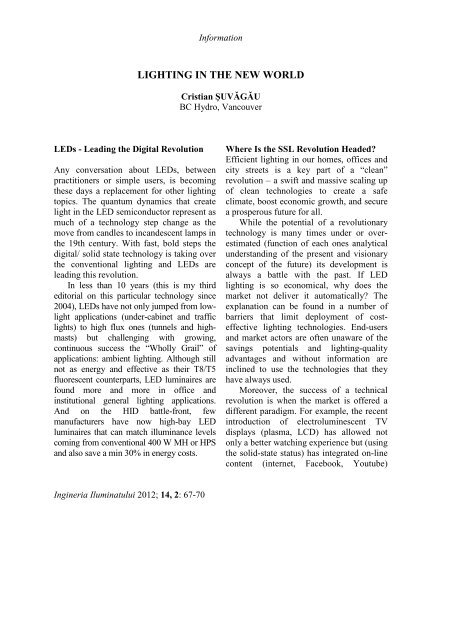Untitled - Journal of Lighting Engineering
Untitled - Journal of Lighting Engineering
Untitled - Journal of Lighting Engineering
Create successful ePaper yourself
Turn your PDF publications into a flip-book with our unique Google optimized e-Paper software.
LEDs - Leading the Digital Revolution<br />
Any conversation about LEDs, between<br />
practitioners or simple users, is becoming<br />
these days a replacement for other lighting<br />
topics. The quantum dynamics that create<br />
light in the LED semiconductor represent as<br />
much <strong>of</strong> a technology step change as the<br />
move from candles to incandescent lamps in<br />
the 19th century. With fast, bold steps the<br />
digital/ solid state technology is taking over<br />
the conventional lighting and LEDs are<br />
leading this revolution.<br />
In less than 10 years (this is my third<br />
editorial on this particular technology since<br />
2004), LEDs have not only jumped from lowlight<br />
applications (under-cabinet and traffic<br />
lights) to high flux ones (tunnels and highmasts)<br />
but challenging with growing,<br />
continuous success the “Wholly Grail” <strong>of</strong><br />
applications: ambient lighting. Although still<br />
not as energy and effective as their T8/T5<br />
fluorescent counterparts, LED luminaires are<br />
found more and more in <strong>of</strong>fice and<br />
institutional general lighting applications.<br />
And on the HID battle-front, few<br />
manufacturers have now high-bay LED<br />
luminaires that can match illuminance levels<br />
coming from conventional 400 W MH or HPS<br />
and also save a min 30% in energy costs.<br />
Ingineria Iluminatului 2012; 14, 2: 67-70<br />
Information<br />
LIGHTING IN THE NEW WORLD<br />
Cristian ŞUVĂGĂU<br />
BC Hydro, Vancouver<br />
Where Is the SSL Revolution Headed?<br />
Efficient lighting in our homes, <strong>of</strong>fices and<br />
city streets is a key part <strong>of</strong> a “clean”<br />
revolution – a swift and massive scaling up<br />
<strong>of</strong> clean technologies to create a safe<br />
climate, boost economic growth, and secure<br />
a prosperous future for all.<br />
While the potential <strong>of</strong> a revolutionary<br />
technology is many times under or overestimated<br />
(function <strong>of</strong> each ones analytical<br />
understanding <strong>of</strong> the present and visionary<br />
concept <strong>of</strong> the future) its development is<br />
always a battle with the past. If LED<br />
lighting is so economical, why does the<br />
market not deliver it automatically? The<br />
explanation can be found in a number <strong>of</strong><br />
barriers that limit deployment <strong>of</strong> costeffective<br />
lighting technologies. End-users<br />
and market actors are <strong>of</strong>ten unaware <strong>of</strong> the<br />
savings potentials and lighting-quality<br />
advantages and without information are<br />
inclined to use the technologies that they<br />
have always used.<br />
Moreover, the success <strong>of</strong> a technical<br />
revolution is when the market is <strong>of</strong>fered a<br />
different paradigm. For example, the recent<br />
introduction <strong>of</strong> electroluminescent TV<br />
displays (plasma, LCD) has allowed not<br />
only a better watching experience but (using<br />
the solid-state status) has integrated on-line<br />
content (internet, Facebook, Youtube)
















